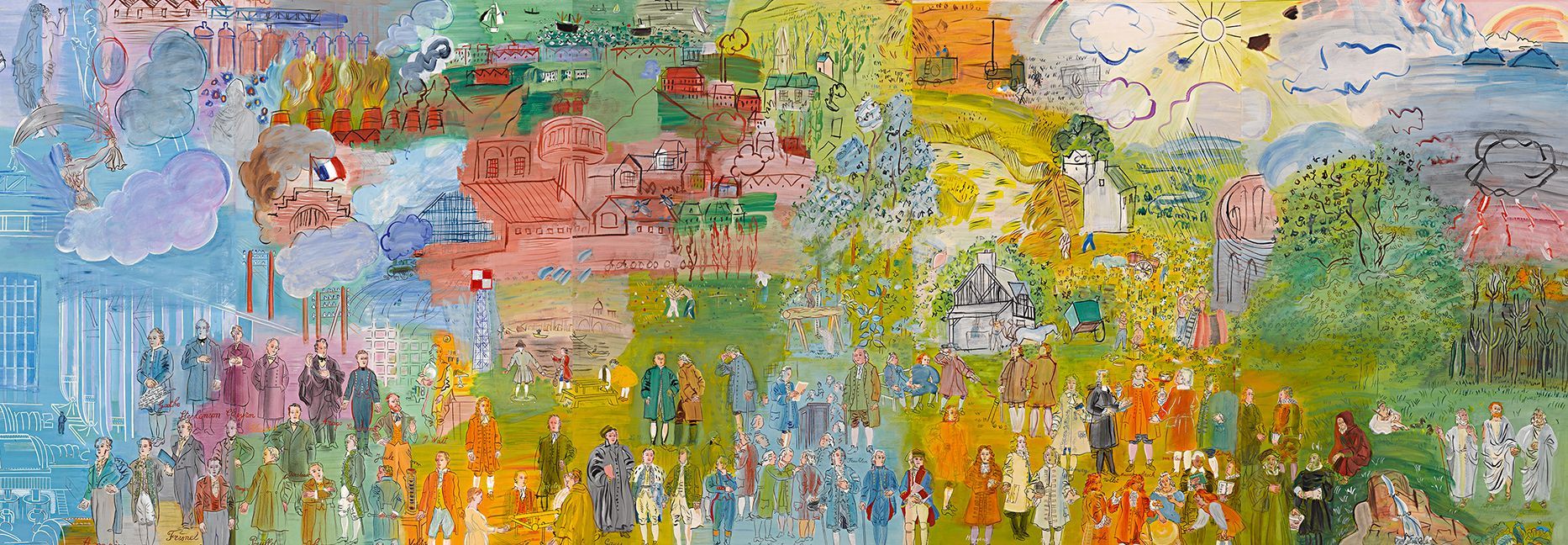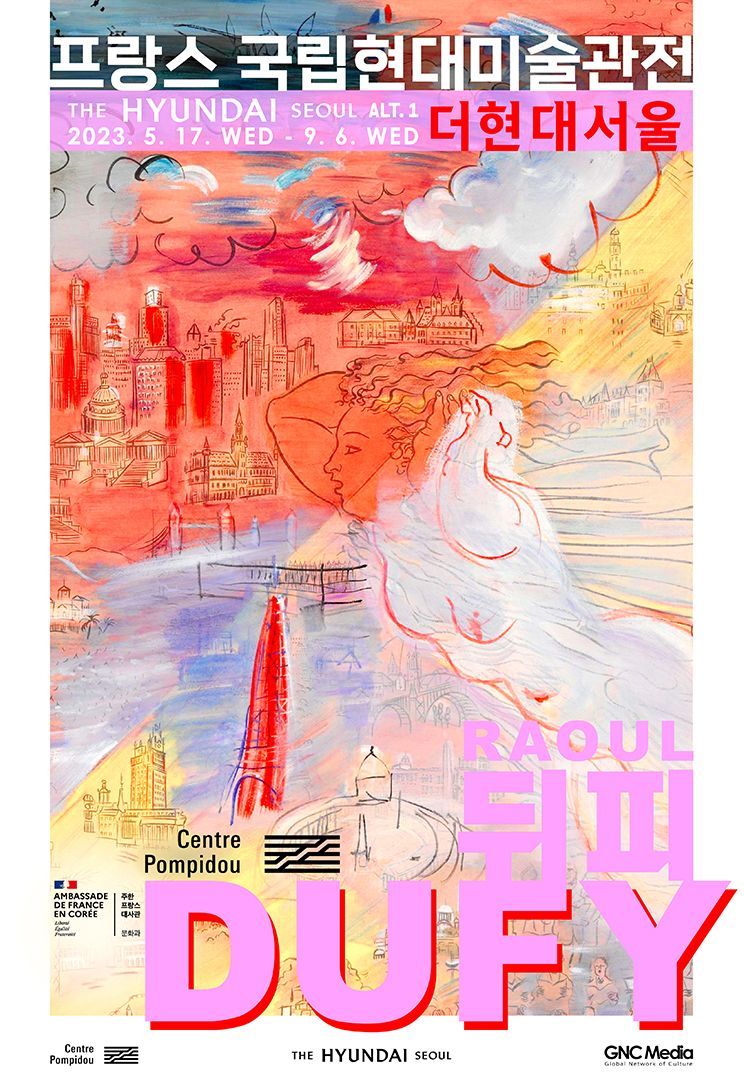The Hyundai Seoul & Centre Pompidou
: Raoul Dufy, Melody of Happiness
May. 17. 2023 - Sep. 6.
The Hyundai Seoul ALT. 1
Consisting of high-quality works from Centre Pompidou, which possesses the largest collection of Raoul Dufy's works, this exhibition encompasses not only painting but also many masterpieces in various fields such as sculpture, drawing, and engraving. Additionally, the exhibition will display Dufy’s greatest masterpiece and the original work of “Electricity Fairy,” which expresses awe and praise of the area of electricity and light with marvelous color and lines. About 130 works will be composed of 12 themes, and the artistic voyage of Raoul Dufy, a painter of blessing and joy, is presented along with spatial design in a modern sense.
The first project of “The Hyundai Seoul” and “Centre Pompidou”
Centre Pompidou – Raoul Dufy, Melody of Happiness
A hip meeting with ‘Classic’ and ‘Trendy’!
Centre Pompidou Raoul Dufy Exhibition will be held in The Hyundai Seoul on May 17, 2023.
The Hyundai Seoul, a gathering place for global K content leading the the latest trend, and Centre Pompidou, one of the three major art museums in France meet,
As the first project <Centre Pompidou Raoul Dufy, Melody of Happiness Exhibition> will be held at ALT. 1 on the 6th floor of The Hyundai Seoul.
Co-hosted by Centre Pompidou, The Hyundai Seoul, and GNC Media and sponsored by the French Embassy in Korea, this exhibition presents the world of Raoul Dufy, one of the crucial artists of the 20th century, in a modern and ingenious style. The exhibition consists of high-quality works from the Centre Pompidou, which has the largest collection of Raoul Dufy’s works, and not only introduces paintings, but also sculpture, drawing, and engraving.
Additionally, through this exhibition, the original work of “Electricity Fairy” will be introduced, which is Dufy’s greatest masterpiece and expresses awe and praise for the era of electricity and light with details of gorgeous colors and lines.
“His art is a pleasure itself”
<Gertrude Stein>
Raoul Dufy, also called the Painter of Joy, was born in 1877 to a poor musician family in Le Havre, France, and grew up with those who loved music and art very much.
Having to work for money from an early age, Dufy officially studied art at the age of 15 and was fascinated by Impressionism at first, but later became deeply attracted to Matisse’s work and joined the Fauvism. Since then, Dufy has created numerous works on the subject of happiness and joy that life gives for a lifetime with a bright, cheerful, but never too light, ingenious painting style. Even to this day, Dufy’s bright and colorful works make the visitors in front of him feel the blessings and joy of the world, putting down the anxiety and burden of the heart.
This exhibition consists of about 130 works in 12 themes, and you may enjoy the artistic voyage of Raoul Dufy, the Painter of Blessings and Joy, along with the direction of the space.
This exhibition consists of 12 themes of a total of 130 works, and you can look at the artistic journey of Raul Duffy, the painter of blessings and joy, along with the spatial design in a modern sense.
Having to work for money from an early age, Dufy officially studied art at the age of 15 and was fascinated by Impressionism at first, but later became deeply attracted to Matisse’s work and joined the Fauvism. Since then, Dufy has created numerous works on the subject of happiness and joy that life gives for a lifetime with a bright, cheerful, but never too light, ingenious painting style. Even to this day, Dufy’s bright and colorful works make the visitors in front of him feel the blessings and joy of the world, putting down the anxiety and burden of the heart.
This exhibition consists of about 130 works in 12 themes, and you may enjoy the artistic voyage of Raoul Dufy, the Painter of Blessings and Joy, along with the direction of the space.
This exhibition consists of 12 themes of a total of 130 works, and you can look at the artistic journey of Raul Duffy, the painter of blessings and joy, along with the spatial design in a modern sense.
Exhibit Composition
<Self-portrait>
The three self-portraits of Raoul Dufy open the first section. His long career as a painter can be divided into three periods through these self-portraits, which are completed in very different styles.
<Impressionist heritage>
Born in Le Havre, an industrial port city located in northwestern France, Normandy, he was first known as a talented landscape painter, initially as a descendant of the Impressionists.
<Fauvism Raoul Dufy>
In 1906, Dufy established himself as one of the leading painters of Fauvism, who rejected tradition and targeted revolution. He and other Fauvist painters used intense colors and light brush strokes to paint landscapes and portraits.
<Cubist Season>
Dufy, along with his friend Georges Braque, attempted stereotactic techniques, and influenced by Paul Cezanne, painted the landscape of L’Estaque near Marseilles in southern France in 1908 from various perspectives.
<Dufy’s Folk Art>
Just before World War I, Raoul Dufy, who became passionate about folk art, made an innovative approach to making a woodblock print illustration of the poem ‘Animal Fable, Funeral Procession of Orphe’ by the poet Guillaume Apollinaire.
<Fashion>
Having to work with a well-known textile manufacturer in Lyon, Dufy created numerous samples and also worked with renowned fashion designer Paul Poiret. Dufy was a leading fashion representative in the 1920s and created his own label.
<Decorative Arts>
Dufy created his own unique style of painting based on separation, naturalness and the vivid and transparent colors of the overlapping design during this period. He also began to create numerous ceramics in 1924 with potter Llorens Artigas, using his natural sense of decoration.
<Sea and Horses>
Dufy also drew paintings based on his painterly inspiration from the marvelous images of a coastal city full of small horses. He also ran a racetrack in his hometown of Normandy and gained great financial success.
<Journey>
He traveled around the world, to Italy, Spain, the United Kingdom, and the United States, and freely depicted the scenery of each country.
<Portraits>
Dufy also had great interest in portraits. From his early days, he modeled his wife, Emilienne, and often drew celebrities over time. The monumental family portrait, commissioned by the Kessler family in 1930, England, is one of the masterpieces that Dufy left behind.
<Monumental Mural>
The 1930s was a period when Raoul Dufy devoted himself to decorating large-scale murals. For example, Electricity Fairy, exhibited at the 1937 World Fair in Paris, was also his work. Through this exhibition, you can meet the Electricity Fairy of Dufy, which was created using lithography. One of the halves vividly depicted the natural scenery preserved in its original state, and the other half vividly depicted the industrial landscape. Many intellectuals involved in the invention of electricity were placed in the landscape of this transitional era.
<Ateliers>
One of the original themes Dufy dealt with was the artist’s own atelier, especially the Guelma Studio, located below the hill of Montmartre in Paris. As he was born into a family of musicians, the artist himself was a great amateur musician, and the subject is closely related to music.
<Black Light>
The final section of the exhibition presents ‘Black Freight Ships’. Dufy used a single shade of black to describe his hometown port, which was almost completely destroyed during World War II. This style of expression allowed the painting to shine brilliantly in the direction of the sunlight.
The three self-portraits of Raoul Dufy open the first section. His long career as a painter can be divided into three periods through these self-portraits, which are completed in very different styles.
<Impressionist heritage>
Born in Le Havre, an industrial port city located in northwestern France, Normandy, he was first known as a talented landscape painter, initially as a descendant of the Impressionists.
<Fauvism Raoul Dufy>
In 1906, Dufy established himself as one of the leading painters of Fauvism, who rejected tradition and targeted revolution. He and other Fauvist painters used intense colors and light brush strokes to paint landscapes and portraits.
<Cubist Season>
Dufy, along with his friend Georges Braque, attempted stereotactic techniques, and influenced by Paul Cezanne, painted the landscape of L’Estaque near Marseilles in southern France in 1908 from various perspectives.
<Dufy’s Folk Art>
Just before World War I, Raoul Dufy, who became passionate about folk art, made an innovative approach to making a woodblock print illustration of the poem ‘Animal Fable, Funeral Procession of Orphe’ by the poet Guillaume Apollinaire.
<Fashion>
Having to work with a well-known textile manufacturer in Lyon, Dufy created numerous samples and also worked with renowned fashion designer Paul Poiret. Dufy was a leading fashion representative in the 1920s and created his own label.
<Decorative Arts>
Dufy created his own unique style of painting based on separation, naturalness and the vivid and transparent colors of the overlapping design during this period. He also began to create numerous ceramics in 1924 with potter Llorens Artigas, using his natural sense of decoration.
<Sea and Horses>
Dufy also drew paintings based on his painterly inspiration from the marvelous images of a coastal city full of small horses. He also ran a racetrack in his hometown of Normandy and gained great financial success.
<Journey>
He traveled around the world, to Italy, Spain, the United Kingdom, and the United States, and freely depicted the scenery of each country.
<Portraits>
Dufy also had great interest in portraits. From his early days, he modeled his wife, Emilienne, and often drew celebrities over time. The monumental family portrait, commissioned by the Kessler family in 1930, England, is one of the masterpieces that Dufy left behind.
<Monumental Mural>
The 1930s was a period when Raoul Dufy devoted himself to decorating large-scale murals. For example, Electricity Fairy, exhibited at the 1937 World Fair in Paris, was also his work. Through this exhibition, you can meet the Electricity Fairy of Dufy, which was created using lithography. One of the halves vividly depicted the natural scenery preserved in its original state, and the other half vividly depicted the industrial landscape. Many intellectuals involved in the invention of electricity were placed in the landscape of this transitional era.
<Ateliers>
One of the original themes Dufy dealt with was the artist’s own atelier, especially the Guelma Studio, located below the hill of Montmartre in Paris. As he was born into a family of musicians, the artist himself was a great amateur musician, and the subject is closely related to music.
<Black Light>
The final section of the exhibition presents ‘Black Freight Ships’. Dufy used a single shade of black to describe his hometown port, which was almost completely destroyed during World War II. This style of expression allowed the painting to shine brilliantly in the direction of the sunlight.








